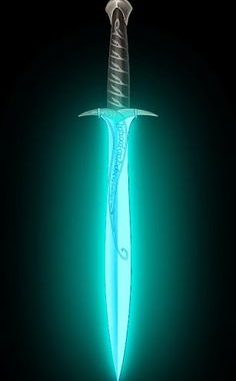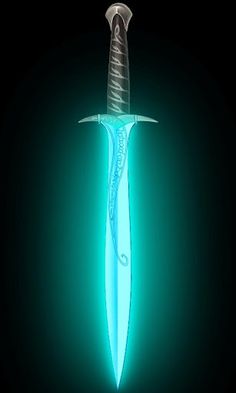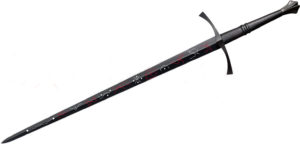
This week we continue our look at two more of the Dead Steel Weapons as unique sentient magic items for your 5th Edition Dungeons and Dragons game by taking a deeper look at Sunspike, the dagger infused with the power of holy clerics and Harrower, the longsword that is the bane of all undead creatures.
 Sunspike
Sunspike
Weapon (dagger), legendary (requires attunement by a creature of good alignment)
An otherwise nondescript dagger forged of black steel, when held by someone worthy it blazes to life, pulsing with light and radiant energy.
You gain a +2 to attack and damage rolls with this weapon. It deals radiant damage and deals an extra 2d4 damage to undead creatures. It has the following additional properties.
Holy Light. When attuned to a wielder, Sunspike continually sheds illumination as if affected by the light cantrip. The wielder can dismiss or reactivate this ability as a bonus action. Once per day they can increase the brightness to the equivalent of the daylight spell for up to 1 minute. Once used, this second property can’t be used again until the next dawn.
Sacred Light. Sunspike has 10 charges. Its wielder can spend 1 charge to cast the sacred flame cantrip as an 11th level Cleric. They can spend 2 charges to turn undead as an 11th level Cleric. Or they can spend 6 charges to cast the sunbeam spell. Sunspike maintains concentration on this spell. It recovers 1d6+4 charges each dawn. The saving throw DC for all of these effects is 15.
Sentience. Sunspike is a sentient weapon of lawful good alignment, with an Intelligence of 14, a Wisdom of 16, and a Charisma of 15. It has normal hearing and vision out to 60 feet and can sense the presence (but not the type) of undead creatures out to 120 feet.
The weapon can speak, read, and understand Common, and can communicate with its wielder telepathically. Its voice is pure and bright, as if a flame burning away corruption.
Personality. Sunspike seeks to protect the living world by destroying the threat of the undead and it pursues this goal with single-minded determination that borders on zeal, but reviles taking away the future of a living creature, even one allied with evil forces. Conflict arises when the wielder fails to destroy undead monsters or when it is used to kill living creatures.
Sunspike believes itself to be the best and most noble of the Dead Steel and constantly impresses this fact on its wielder. However, Sunspike secretly abhors the nature of its creation and will occasionally lapse into depressive episodes if it dwells on the fact too much or is strongly reminded of it.
Harrower
Weapon (longsword), legendary (requires attunement by a creature of good alignment)
This longsword is made of black steel and is covered in arcane runes that pulse white and red while wielded in combat. Its sheath is rather unassuming, appearing to be a well worn scabbard of brown leather, capped in brass with an accompanying belt.
You gain a +1 to attack and damage rolls with this weapon. Against undead, this bonus increases to +3, and the weapon deals an extra 1d8 damage. While wielding Harrower, you have resistance to necrotic damage, and you have advantage on any saving throws an undead creature forces you to make. It has the following abilities.
Harrow. An undead creature struck by this weapon must make a DC 14 Constitution saving throw. Failure causes the creature to burn with holy fire. At the start of each of its turns, it takes 10 points of radiant damage. A creature can repeat the saving throw at the end of each of its turns, ending the effect on itself on a success. This does not stack from multiple uses. Creatures reduced to 0 hit points while affected by this property are utterly consumed in a flash of flame and leave behind only a pile of ash.
Sentience. Harrower is a sentient weapon of lawful good alignment, with an Intelligence of 15, a Wisdom of 11, and a Charisma of 14. It has normal hearing and vision out to 60 feet and can sense the presence (but not the type) of undead creatures out to 120 feet.
The weapon can speak, read, and understand Common, and can communicate with its wielder telepathically. Its speaks with an imperious, commanding voice.
Personality. Harrower is devoted to the protection of life through the destruction of the undead. Conflict occurs when the wielder fails to destroy undead creatures. Unlike, Sunspike, Harrower understands that sometimes living creatures serve the forces of undeath and must be dealt with, however, it is always sad at having to take a life.
Harrower also sees itself as the “leader” of the Dead Steel Weapons and routinely butts heads with Sunspike when the two are together about the best course of action.
Next time we will wrap this series up by looking at the final Dead Steel Weapon, the greatsword Corpsebane and explore various hooks and ways to use these weapons in your own campaign, either as simple window dressing of the game world’s history or as centerpieces for an entire campaign.

The first pair seemed pretty clearly themed to deal with specific types of undead — Shadows Splitter with incorporeals, Bonecrush for skeletons. Sunspike obviously works well against vampires (and to a lesser extent, shadows and specters), the ones who are specifically vulnerable to sunlight. And I assume Corpsebane is all about taking down zombies and similar animated corpses.
But Harrower I’m having a harder time with. What’s it’s specialty? Is it just supposed to be the Mario, good against everything but great against nothing?
Basically that. It was more or less a love letter to classic undead bane weapons. In fact it’s very name is taken from Baldur’s Gate EE where it was a very similar weapon.
I think you’ll find Corpsebane to be kind of an odd duck when you see it next week, but interesting nonetheless – it’s a slightly different idea of dealing with the undead than the others.